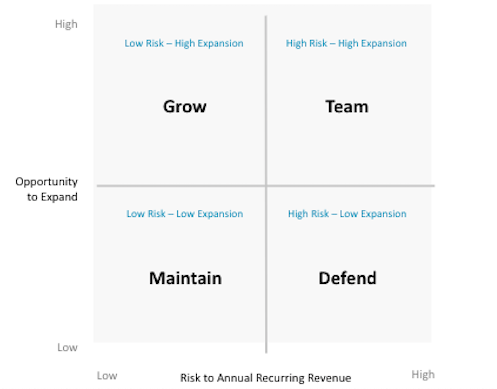3 Steps to Drive Breakthrough Growth Within Your Account Base
In this blog, based on a webinar with SOAR and People.ai, learn why customer growth is critical in the current market and how your team can prioritize, plan, and execute to drive breakthrough growth within your account base.
Why Customer Growth is Critical
Pre-economic downturn, the focus was on opportunity execution. At SOAR, we have determined four reasons for an increasing focus on customer growth and retention among our clients post-economic downturn:
1. Changes in buyer behavior.
Sales cycles are currently 20-30% longer for net new logos than a few years ago, partially due to increased business case scrutiny among potential buyers. So, renewing with current customers is quicker and easier than chasing new logos.
2. Economic advantages of expansion.
When selling to current customers, there is a 5x lower cost and 30% higher win rate than selling to new customers, according to TSIA.
3. Impact on Net Revenue Retention (NRR) and Lifetime Value (LTV).
Without an effective expand motion, NRR hits a ceiling. According to TSIA, customers that expand before renewal renew at a 78% higher rate than those that don’t.
4. NRR drives valuation.
According to Gainsight, NRR has the highest correlation with valuation of any other metric.
As you can see, expanding within your existing account base is easier and more cost effective in the current environment than chasing net new logos. Now that we’ve covered why you should focus on growing your existing accounts, let’s talk about how to grow your existing accounts.
3 Steps to Drive Breakthrough Growth Within Your Account Base
[Prioritize]
The first step to driving breakthrough growth within your account base is to prioritize the existing accounts you want to focus on. And the first step to prioritizing is to ask these three questions about each of your accounts:
- Do you know the original value they purchased?
- Can you prove that value?
- What are new areas of value you can offer to this customer?
Value realization is necessary but not sufficient for account expansion. To expand, you must move beyond value realization to identify and grow new areas of value to a customer. Customers often expand for a different reason from the original reason they purchased.
The SOAR Account Prioritization Framework
When considering new areas of value you can offer to a customer, segmentation alone does not offer actionable insight for retention and expansion. Many organizations do not have the right account profiling or know how to prioritize spending their time across those accounts. At SOAR, we recommend shifting your account segmentation pyramid—including Enterprise, Mid market, SMB—to an account prioritization quadrant—dividing accounts into four categories: Grow, Team, Maintain, Defend. To decide which quadrant an account belongs in, consider opportunity vs. risk: what is the opportunity to expand in this account and what is the risk associated in terms of annual recurring revenue?

Grow accounts are low risk/high expansion. These accounts involve a sales led motion and a focus to drive expansion. Team accounts are high risk/high expansion. Team across sales and CS for an integrated approach to reduce risk and maximize expansion in these accounts. Maintain accounts are low risk/low expansion. We recommend employing strategies like a lower touch model and digital CS to apply your resources where there is the greatest potential. Defend accounts are high risk/low expansion and involve a heavily CS led motion. A challenge in this strategy for prioritizing accounts can be unifying sales and CS to work together in these motions. Account planning will help with this.
[Plan]
Once you have prioritized your existing accounts, you must build a good plan around them. Account planning creates the opportunities for you to drive new outcomes and to expand the account.
Keep in mind: strong retention does not ensure strong expansion. Retention and expansion are different motions and require different plays. To expand within the customer base, first get more specific in account prioritization—using the SOAR Account Prioritization Framework above—then think through the prescriptive plays in your business that will have an impact based on which quadrant an account falls in. For example, a Grow account would benefit from a value expansion play. A Maintain account would benefit from automated status alerts. A Team account would benefit from a new use case or outcome play. A Defend account would benefit from a proof of value play. These are just a few examples of how to tailor your account plans to each account.
Another way to optimize your account planning process is by automating with People.ai through Salesforce. People.ai offers, among other things, account scorecards, whitespace maps, and account maps. Check out their website for more information.
[Execute]
Account Planning
Organizations often focus too much on account planning and not enough on execution. Keep account planning simple, actionable, and forward looking to enable a strong execution cadence.
We recommend sticking to four important elements of account planning:
- Situation: Where are we today?
- Objectives: Where do we want to get in the future?
- Advancement strategies: How are we going to get there?
- Resources and action: How are we going to make it happen?
As you can see, this model keeps an account plan 75% forward looking, with only 25% focused on the current situation. This promotes execution. Based on a SOAR customer survey, we have found that account plans with at least 3 strategies and 3 actions executed per strategy have greater than 60% more pipeline than those that don’t.
Training
A major hindrance to execution can be your team’s skillset. Customer growth requires a different skillset than account acquisition. A lot of hires over the past 5-10 years have focused on acquisition, so you may have to implement some training to enable the shift from focusing on account acquisition to account expansion.
Sales skills required in expansion that you may need to include in training: long term relationship development skills, strategic thinking skills, influencing/coaching a larger group of people involved in the account, and executive engagement—both internal and external. CS skills needed will also change. Over the past 5 years, there has been a 60% increase in the number of organizations where CS has revenue responsibility. CS skills you may need to train for include business discovery, value articulation, influence, executive engagement, and negotiation.
Need Help Driving Breakthrough Growth in Your Account Base?
Contact us for more information about how SOAR can enable your teams to prioritize, plan, and execute within your account base.

